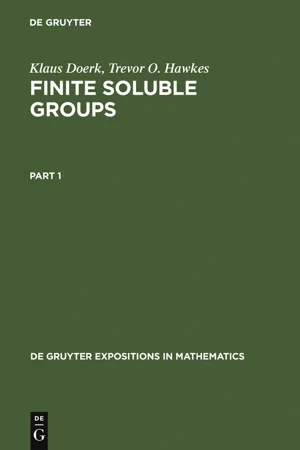
This is a test
- 901 pages
- English
- PDF
- Available on iOS & Android
eBook - PDF
Finite Soluble Groups
Book details
Table of contents
Citations
Frequently asked questions
At the moment all of our mobile-responsive ePub books are available to download via the app. Most of our PDFs are also available to download and we're working on making the final remaining ones downloadable now. Learn more here.
Both plans give you full access to the library and all of Perlego’s features. The only differences are the price and subscription period: With the annual plan you’ll save around 30% compared to 12 months on the monthly plan.
We are an online textbook subscription service, where you can get access to an entire online library for less than the price of a single book per month. With over 1 million books across 1000+ topics, we’ve got you covered! Learn more here.
Look out for the read-aloud symbol on your next book to see if you can listen to it. The read-aloud tool reads text aloud for you, highlighting the text as it is being read. You can pause it, speed it up and slow it down. Learn more here.
Yes, you can access Finite Soluble Groups by Klaus Doerk, Trevor O. Hawkes in PDF and/or ePUB format, as well as other popular books in Mathematics & Mathematics General. We have over one million books available in our catalogue for you to explore.
Information
Table of contents
- Preface
- Notes for the reader
- Chapter A Prerequisites — general group theory
- 1. Groups and subgroups — the rudiments
- 2. Groups and homomorphisms
- 3. Series
- 4. Direct and semidirect products
- 5. G-sets and permutation representations
- 6. Sylow subgroups
- 7. Commutators
- 8. Finite nilpotent groups
- 9. The Frattini subgroup
- 10. Soluble groups
- 11. Theorems of Gaschütz, Schur-Zassenhaus, and Maschke
- 12. Coprime operator groups
- 13. Automorphism groups induced on chief factors
- 14. Subnormal subgroups
- 15. Primitive finite groups
- 16. Maximal subgroups of soluble groups
- 17. The transfer
- 18. The wreath product
- 19. Subdirect and central products
- 20. Extraspecial p-groups and their automorphism groups
- 21. Automorphisms of abelian groups
- Chapter B Prerequisites — representation theory
- 1. Tensor products
- 2. Projective and injective modules
- 3. Modules and representations of K-algebras
- 4. The structure of a group algebra
- 5. Changing the field of a representation
- 6. Induced modules
- 7. Clifford’s theorems
- 8. Homogeneous modules
- 9. Representations of abelian and extraspecial groups
- 10. Faithful and simple modules
- 11. Modules with special properties
- 12. Group constructions using modules
- Chapter I. Introduction to soluble groups
- 1. Preparations for the paqb-theorem of Burnside
- 2. The proof of Burnside’s paqb-theorem
- 3. Hall subgroups
- 4. Hall systems of a finite soluble group
- 5. System normalizers
- 6. Pronormal subgroups
- 7. Normally embedded subgroups
- Chapter II Classes of groups and closure operations
- 1. Classes of groups and closure operations
- 2. Some special classes defined by closure properties
- Chapter III. Projectors and Schunck classes
- 1. A historical introduction
- 2. Schunck classes and boundaries
- 3. Projectors and covering subgroups
- 4. Examples
- 5. Locally-defined Schunck classes and other constructions
- 6. Projectors in subgroups
- Chapter IV. The theory of formations
- 1. Examples and basic results
- 2. Connections between Schunck classes and formations
- 3. Local formations
- 4. The theorem of Lubeseder and the theorem of Baer
- 5. Projectors and local formations
- 6. Theorems about f-hypercentral action
- Chapter V. Normalizers
- 1. Normalizers in general
- 2. Normalizers associated with a formation function
- 3. ℱ-normalizers
- 4. Connections between normalizers and projectors
- 5. Precursive subgroups
- Chapter VI. Further theory of Schunck classes
- 1. Strong containment and the lattice of Schunck classes
- 2. Complementation in the lattice
- 3. D-classes
- 4. Schunck classes with normally embedded projectors
- 5. Schunck classes with permutable and CAP projectors
- Chapter VII. Further theory of formations
- 1. The formation generated by a single group
- 2. Supersoluble groups and chief factor rank
- 3. Primitive saturated formations
- 4. The saturation of a formation
- 5. Strong containment for saturated formations
- 6. Extreme classes
- 7. Saturated formations with the cover-avoidance property
- Chapter VIII. Injectors and Fitting sets
- 1. Historical introduction
- 2. Injectors and Fitting sets
- 3. Normally embedded subgroups are injectors
- 4. Fischer sets and Fischer subgroups
- Chapter IX. Fitting classes — examples and properties related to injectors
- 1. Fundamental facts
- 2. Constructions and examples
- 3. Fischer classes, normally embedded, and permutable Fitting classes
- 4. Dominance and some characterizations of injectors
- 5. Dark’s construction — the theme
- 6. Dark’s construction — variations
- Chapter X. Fitting classes — the Lockett section
- 1. The definition and basic properties of the Lockett section
- 2. Fitting classes and wreath products
- 3. Normal Fitting classes
- 4. The Lausch group
- 5. Examples of Fitting pairs and Berger’s theorem
- 6. The Lockett conjecture
- Chapter XI. Fitting classes — their behaviour as classes of groups
- 1. Fitting formations
- 2. Metanilpotent Fitting classes with additional closure properties
- 3. Further theory of metanilpotent Fitting classes
- 4. Fitting class boundaries I
- 5. Fitting class boundaries II
- 6. Frattini duals and Fitting classes
- Appendix α. A theorem of Oates and Powell
- Appendix β. Frattini extensions
- Bibliography
- List of Symbols
- Index of Subjects
- Index of Names